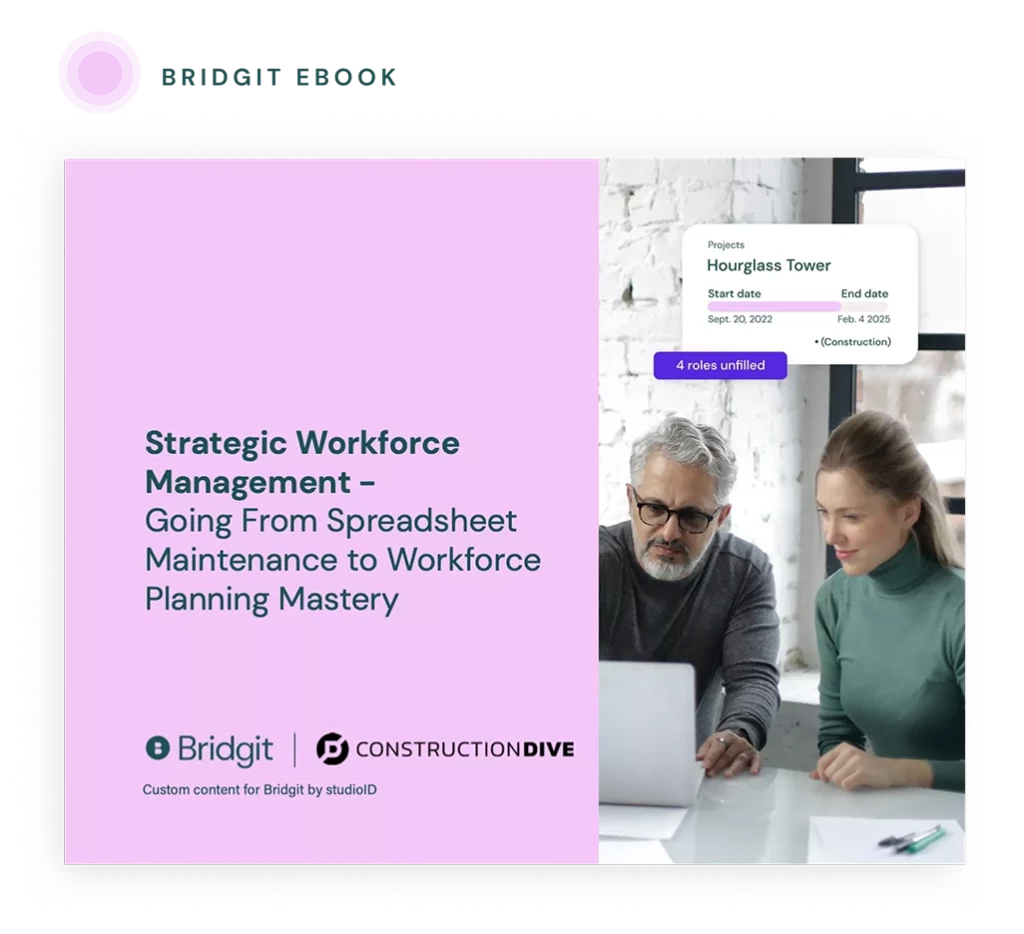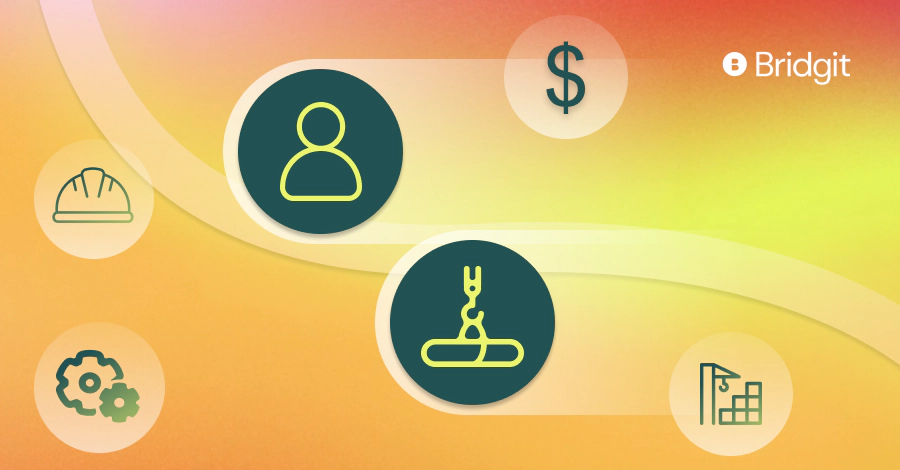Human capital and physical capital are both very important for any construction company. Keep reading as we take a closer look at these asset classifications and how they fit into the world of construction resource management.
Table of Contents
What is the difference between physical and human capital in construction?
Physical capital consists of inanimate assets such as cash, job site equipment, property, and inventory. Human capital, meanwhile, describes the skills, knowledge, and capabilities associated with a company’s personnel.
Let’s take a closer look at the practical differences between human and physical capital in construction.
How their value is tracked and measured
The process of tracking and measuring physical capital’s value is quite logical. For example, a construction company can list equipment’s market value on its balance sheet and account for depreciation in a relatively predictable manner.
Human capital, on the other hand, is intangible. It doesn’t appear on a company’s balance sheet. After all, organizations don’t own workers. The value of a company’s human capital could drop at any time if key personnel departs.
Additionally, measuring human capital’s value involves an arguably more complex set of metrics, including:
- time to hire
- cost per hire
- revenue per employee
- turnover
- billable hours per employee
- absenteeism
- workforce utilization ratio
Read this article for more information about calculating construction labor costs, which is a key part of measuring human capital.
The nature of investments
Construction companies invest in both human capital and physical capital. However, the nature of these investments – including who ultimately benefits from them – differs.
With physical capital, things follow relatively straightforward logic, once again.
Picture this scenario. A construction company purchases new equipment that will improve job site performance. That investment will benefit the company directly. There’s no risk of a competitor somehow deriving direct financial benefits from that new equipment.
This might seem like an odd point to belabor but it underscores a very important difference between investments in human capital and physical capital.
You see, human capital investments are split into two categories:
- Specific human capital investments primarily benefit the company making them. As with physical capital investments, there’s little risk of competitors deriving direct financial benefits.
- General human capital investments improve a workforce’s capabilities through training and other strategies that could conceivably benefit any competitors your employees work for in the future.
Read about these two classifications that were identified by the University of Chicago economists Gary Becker and Theodore Schultz.
Check out this post to find a concrete framework for strategic human capital investment planning.

Looking to be more strategic with your people?
We partnered with Construction Dive to outline the steps any contractor can take to be more strategic with their workforce management.
Mitigating risks associated with general human capital investments
Imagine you make a general human capital investment and a handful of workers subsequently leave to work for a competitor. That company now benefits from your investment in that they enjoy the worker’s increased productivity and skill while paying less for it than you did.
It’d be like renting a piece of equipment, paying to make it run more efficiently, and then sending it to a competitor who now gets to rent that improved unit at the same exact price you did.
This is a particular risk with human capital investments that improve soft skills like communication, decision-making, and organization. These skills, unlike formal qualifications, may not translate directly into higher pay that would offset the competitive edge a future employer receives.
Many construction companies mitigate against these and other generic human capital investment risks by using non-compete competitors. These restrict employees from working for direct competitors.
Of course, this isn’t always practical in the construction industry, especially for companies that utilize independent contractors. Getting independent contractors to sign non-compete contracts can cause legal issues. Additionally, these contracts aren’t easily enforceable. Read more.
Given the challenges of controlling general human capital investments in construction, some companies minimize them.
Human capital comes with important social considerations
Human and physical capital differ in ways that go far beyond financial considerations.
While physical capital is a largely economic concept, human capital has very important social ramifications. In fact, handling human capital with a purely economic focus raises ethical issues many construction companies try to avoid at all costs.
The construction industry has been particularly hammered by complaints of limited diversity, with the U.S. Bureau of Labor Statistics reporting that women comprise just 9% of workers in the space.
Research indicates increasing diversity in construction is crucial for getting the industry out of its current productivity slump.
Of course, we don’t talk about physical capital in the same sense. Even when it comes to the importance of a diversified tool and technology set, social factors aren’t at play. It’s a purely economic and technical discussion.
Liquidity
Another key difference between human and physical capital concerns liquidity. Physical capital, such as construction equipment, can be sold very quickly. Human capital can’t be sold at all. Instead, financial benefits are derived from utilizing that personnel effectively.
This is an important consideration when building a financially stable construction company. You need a balance between liquid physical capital and intangible human capital.
Physical capital can be lost in ways human capital cannot
As long as a construction company retains personnel, its investments in human capital are secure. This is because you can’t separate human capital from its owners, the workers. The value lies in their capabilities and skills.
Physical capital, on the other hand, can be misplaced, damaged, and stolen. This is actually a major concern for construction companies. According to one research paper, larger construction companies face devastating impacts when it comes to theft whereas smaller companies endure costlier effects in terms of property damage.
This is a crucial consideration from the perspective of making secure investments.
Human capital and physical capital have different mobilities
Barring trade barriers, transporting physical capital internationally is often simpler than with human capital, which is subject to immigration and cultural concerns.
Even though there are established processes for handling immigration concerns, companies still need employees that are willing to relocate. This is the only means of directly transferring human capital to another country given that it can’t be separated from its owner, the worker.
Physical capital such as equipment, meanwhile, requires no coaxing. It’s inanimate!
What is an Example of Human Capital?
Human capital is the lifeblood of the construction industry, embodying the knowledge, skills, and expertise that fuel innovation and productivity. This critical asset exists in diverse forms, influencing everything from on-site execution to high-level strategic planning. Let’s explore the key pillars of human capital in construction.
- Skilled Laborers and Tradespeople
- Specialized Experts
- Safety Leaders
Skilled Laborers and Tradespeople
Skilled laborers and tradespeople form the heart of every construction project. From electricians wiring intricate systems to welders creating sturdy structures, their hands-on expertise transforms blueprints into reality. These professionals, with their unmatched technical acumen, ensure projects not only meet but often exceed expectations.
Specialized Experts
The construction industry thrives on the brilliance of specialized experts. Engineers meticulously design systems that stand the test of time, while architects envision structures that marry beauty with functionality. Project managers, armed with their unparalleled organizational skills, orchestrate the myriad moving parts of a build, ensuring deadlines are met and budgets remain intact. Their combined efforts are a testament to the power of human ingenuity.
Safety Leaders
Safety leaders are the unsung heroes of construction sites, championing the well-being of every worker. They navigate complex safety regulations with precision, creating environments where workers can thrive without unnecessary risk. By proactively addressing potential hazards, they safeguard lives and elevate the standards of the entire industry.
We hope this article has helped you understand the difference between human capital and physical capital.
While there are substantial differences between the two, both are incredibly crucial assets of any successful construction company. Any effective construction resource management plan considers both types of capital.
For more construction resource management tips, visit our blog.
Human capital and physical capital FAQ
Is it possible to accurately measure the ROI of investments in human capital versus physical capital?
The ROI of human capital can be more difficult to measure than physical capital. Materials have an intrinsic value both in acquisition costs and in the estimated value once used in construction. Human capital requires different methodologies which are a bit more qualitative than quantitative. Measuring metrics like productivity rates, reduction in turnover, and increases in innovation are solid indicators of ROI.
What technologies are used for human capital management?
Construction firms are turning to software applications for workforce management, such as Bridgit Bench. These tools help ensure effective management of people through scheduling, time tracking, performance monitoring, and training programs. It helps project managers move from haphazard, manual tracking methods to an organized, automated, and real-time approach to workforce planning and management. For larger organizations, this type of software is increasingly essential for making sure you get the most out of your people.
What is the difference between physical and human capital quizlet-style?
- Physical Capital: Tangible assets such as tools, machinery, and buildings used in production.
- Human Capital: Intangible qualities such as education, expertise, and creativity within the workforce.
- Physical capital is owned and depreciates over time, while human capital cannot be owned and is developed through training and experience.
What is the significance of physical capital in construction?
Physical capital in construction refers to the tools and machinery that streamline operations, reduce errors, and enhance productivity. Examples include cranes, concrete mixers, and advanced software. Properly maintained physical capital prevents disruptions and ensures projects remain on schedule.
How can construction companies measure the value of human capital?
Unlike physical capital, human capital does not appear on balance sheets. Its value is measured through metrics such as revenue per employee, time to hire, workforce utilization, and turnover rates. These indicators provide insights into the productivity and efficiency of a company’s workforce.
How do physical and human capital differ in mobility?
Physical capital, like machinery, can be transported internationally with ease. Human capital, however, is tied to individuals and subject to immigration laws and willingness to relocate. This distinction often complicates global workforce deployment.



